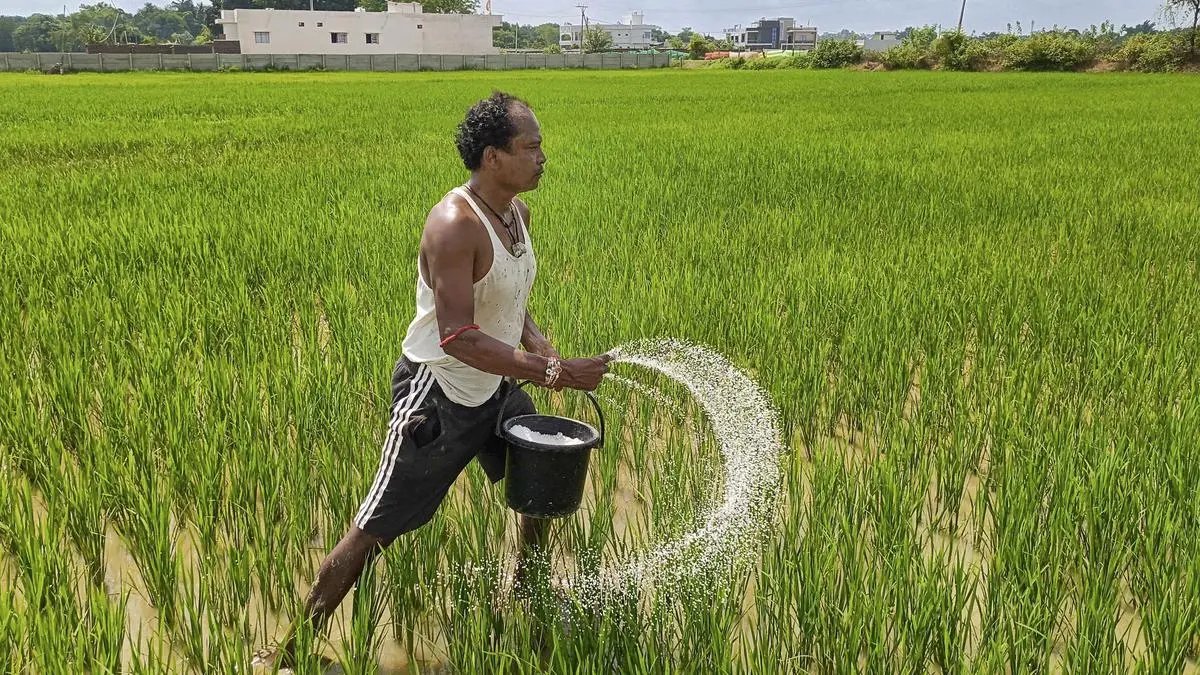Indian agriculture becoming powerful instrument of foreign policy


File Photo: A farmer spreads fertilizer in a field, in Bastar, Chhattisgarh, Sunday, Aug. 10, 2025.
| Photo Credit:
PTI
Once primarily focused on domestic food self-sufficiency, Indian agriculture is undergoing a fundamental strategic shift. Spurred by geopolitical conflicts, climate change, and supply chain vulnerabilities, the sector is increasingly becoming a powerful instrument of foreign policy. India is now leveraging its agrarian strength to forge new alliances, secure trade benefits, and project its influence on the global stage. India’s agriculture policy is integrating the diplomacy, investment, and technology.
Food diplomacy builds goodwill and regional stability:
Using its surplus to help needy nations, this “food diplomacy” strengthens diplomatic ties and solidifies India’s image as a responsible global actor.
- During the 2022 wheat crisis, for example, India made specific, case-by-case exceptions to its export ban for friendly nations under neighbourhood first policy.
- It permitted a private wheat consignment of 61,500 metric tons (MT) for Egypt.
- It committed 50,000 MT of wheat as humanitarian assistance to Afghanistan.
This strategic deployment of food aid, combined with the transfer of agricultural technology to neighbours, fosters regional stability and goodwill.
Strategic partnerships and trade expansion:
India is forging agricultural partnerships to secure its supply chains, diversify risks, and build new alliances.
- India-Middle East Food Corridor.
- Diversifying fertilizer sources.
- New market access.
India–UAE food security partnership: A model
The India–UAE partnership exemplifies how agricultural cooperation can strengthen foreign policy objectives. Under the I2U2 framework, the UAE committed USD 2 billion in 2022 to establish integrated food parks across India (ORF ,2023), aimed at enhancing food security and agricultural exports. Maharashtra, with its strong agro-industrial base, has emerged as an important partner in this initiative. Earlier, in 2019, UAE entities led by Emaar proposed investments in logistics and food processing in Maharashtra, Gujarat, and Madhya Pradesh (WAM News 2019). The India–UAE Food Corridor, formalized under the 2022 (CEPA Economic Times 2024), and the Agriota digital platform linking Indian farmers to UAE markets.
Championing millets and sustainable practices:
The UN’s declaration of 2023 as the International Year of Millets, following an Indian proposal, has positioned the country as a leader in global food security solutions. This enhances its development partnerships, particularly with African nations, which also produce millets.
The Indian Ocean as a strategic trade highway:
India agriculture has Access to vital markets through ocean. The vast coastline with numerous ports allows India to maintain close contact with West Asia, Africa, and Europe from its western coast, while the eastern coast facilitates trade with Southeast Asia and East Asia.
The continental crossroads: Central Asia and beyond:
India’s access to Central Asia via Iran’s Chabahar port is crucial for bypassing a hostile Pakistan and diversifying its energy and trade partnerships.
India’s role in addressing the food gap:
India is addressing global food by its production capacity and strategic location by exports, food aid, sustainability leadership and developing infrastructure for trade.
The path forward: From reactive to proactive
While successful, India’s agricultural foreign policy remains hampered by inconsistent practices, particularly abrupt export restrictions. To fully harness its agrarian economy as a tool of foreign policy, a more proactive and stable strategy is essential. This requires consistent policies that balance domestic needs with international reliability.
- Steps toward a more proactive strategy.
- Invest in value-addition, market access, diversified exports.
- Enhance infrastructure.
- Secure input supplies.
- Maintain policy consistency.
By implementing these measures, India can ensure its agricultural economy grows not just as a domestic asset but as a robust and respected instrument of its foreign policy, asserting its position in an increasingly competitive world. Also, by consistently investing in infrastructure, leveraging its strategic geography for trade and diplomacy, and institutionalising policy consistency, India can turn its inherent locational advantage into a decisive tool for advancing its geopolitical and economic ambitions. By focusing more on India’s agricultural foreign policy, India can transition its agricultural foreign policy from reactive to strategic, ensuring that its agrarian strength serves its geopolitical ambitions with consistency, reliability, and long-term impact.
The author is an agriculture economist
Published on October 25, 2025


